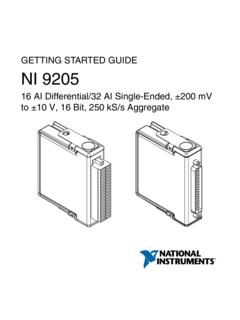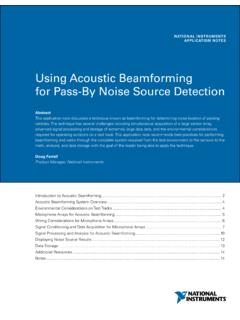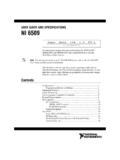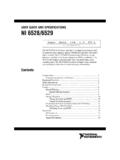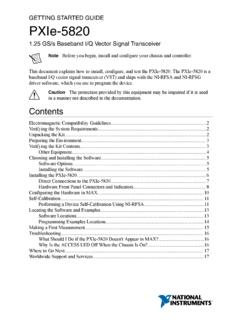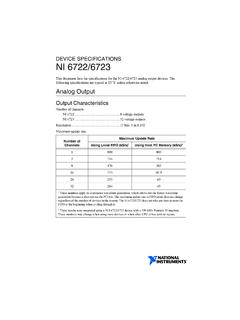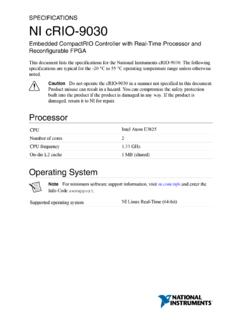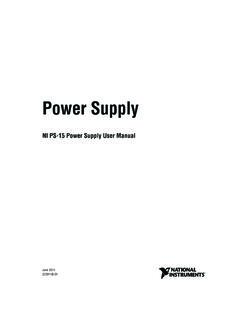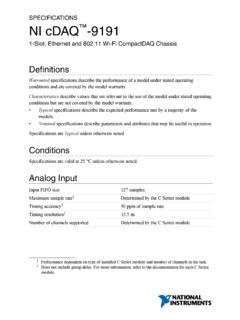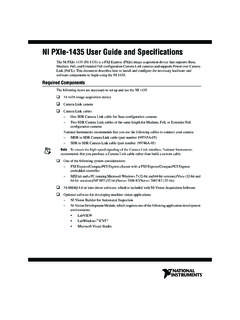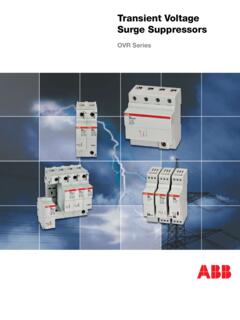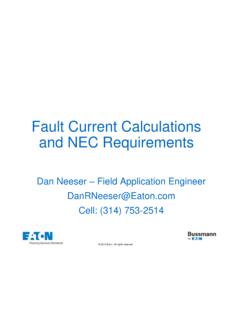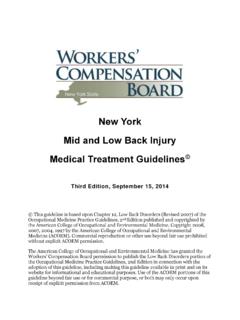Transcription of PCI/PXI/PCIe-6509 User Guide and Specifications - National ...
1 USER Guide AND SPECIFICATIONSPCI/PXI/PCIe-6509 This document contains information about using the PCI-6509, PXI-6509, and PCIe-6509 data acquisition devices with the NI-DAQmx driver information about using the USB-6509 device, refer to the NI USB-6509 User Guide and Specifications NI 6509 is a 96-bit, high-drive digital input/output (DIO) device. The NI 6509 features 96 TTL/CMOS-compatible digital I/O lines, 24 mA high-drive output, digital filtering, programmable power-up states, change detection, and a watchdog Compatibility Guidelines .. 4 Programming Devices in 5 Functional Overview .. 5I/O Connector ..6 Pin Assignments ..7 Signal 11 Static DIO on NI 6509 11I/O Protection .. 11I/O Pull-Up/Pull-Down Resistors (PCIe-6509 Only).. 11 Signal 12 Protecting Inductive 13 Sinking and Sourcing 14 Power +5 V Power Available at I/O Connector.
2 15 Disk Drive Power Connector (PCIe-6509 Only).. 15 Industrial DIO Features .. 16 Digital Filtering .. 16 Programmable Power-Up 18 Change Detection .. 18 Watchdog 20 Digital Logic Levels (PCI/PXI-6509) .. 212| | PCI/PXI/PCIe-6509 User Guide and SpecificationsDigital Logic Levels (PCIe-6509)..22 Physical ..24 Electromagnetic Product to Go Support and Services ..26 Safety InformationThis section contains important safety information that you must follow when installing and using National Instruments DIO not operate the device in a manner not specified in this document. Misuse of the DIO device can result in a hazard. You can compromise the safety protection built into the DIO device if it is damaged in any way. If the DIO device is damaged, return it to NI for not substitute parts or modify the DIO device except as described in this document.
3 Use the DIO device only with the chassis, modules, accessories, and cables specified in the installation instructions. You must have all covers and filler panels installed during operation of the DIO not operate the DIO device in an explosive atmosphere or where there may be flammable gases or you need to clean the DIO device, use a soft, nonmetallic brush. Make sure that the DIO device is completely dry and free from contaminants before returning it to the DIO device only at or below Pollution Degree 2. Pollution is foreign matter in a solid, liquid, or gaseous state that can reduce dielectric strength or surface resistivity. The following is a description of pollution degrees: Pollution Degree 1 means no pollution or only dry, nonconductive pollution occurs. The pollution has no influence. Pollution Degree 2 means that only nonconductive pollution occurs in most cases.
4 Occasionally, however, a temporary conductivity caused by condensation must be expected. Pollution Degree 3 means that conductive pollution occurs, or dry, nonconductive pollution occurs that becomes conductive due to must insulate signal connections for the maximum voltage for which the DIO device is rated. Do not exceed the maximum ratings for the DIO device. Do not install wiring while the DIO device is live with electrical signals. Do not remove or add connector blocks when power PCI/PXI/PCIe-6509 User Guide and Specifications | National Instruments|3is connected to the system. Avoid contact between your body and the connector block signal when hot swapping modules. Remove power from signal lines before connecting them to or disconnecting them from the DIO the DIO device at or below the measurement category1 marked on the hardware label.
5 Measurement circuits are subjected to working voltages2 and transient stresses (overvoltage) from the circuit to which they are connected during measurement or test. Installation categories establish standard impulse withstand voltage levels that commonly occur in electrical distribution systems. The following is a description of installation categories: Measurement Category I is for measurements performed on circuits not directly connected to the electrical distribution system referred to as MAINS3 voltage . This category is for measurements of voltages from specially protected secondary circuits. Such voltage measurements include signal levels, special equipment, limited-energy parts of equipment, circuits powered by regulated low- voltage sources, and electronics. Measurement Category II is for measurements performed on circuits directly connected to the electrical distribution system.
6 This category refers to local-level electrical distribution, such as that provided by a standard wall outlet (for example, 115 V for or 230 V for Europe). Examples of Measurement Category II are measurements performed on household appliances, portable tools, and similar DIO devices. Measurement Category III is for measurements performed in the building installation at the distribution level. This category refers to measurements on hard-wired equipment such as equipment in fixed installations, distribution boards, and circuit breakers. Other examples are wiring, including cables, bus-bars, junction boxes, switches, socket-outlets in the fixed installation, and stationary motors with permanent connections to fixed installations. Measurement Category IV is for measurements performed at the primary electrical supply installation (<1,000 V).
7 Examples include electricity meters and measurements on primary overcurrent protection devices and on ripple control Compatibility GuidelinesThis product was tested and complies with the regulatory requirements and limits for electromagnetic compatibility (EMC) as stated in the product Specifications . These requirements and limits are designed to provide reasonable protection against harmful interference when the product is operated in its intended operational electromagnetic environment. There is no guarantee that interference will not occur in a particular installation. To minimize the potential for the product to cause interference to radio and television reception or to experience unacceptable performance degradation, install and use this product in strict accordance with the instructions in the product Measurement categories, also referred to as installation categories, are defined in electrical safety standard IEC Working voltage is the highest rms value of an AC or DC voltage that can occur across any particular MAINS is defined as a hazardous live electrical supply system that powers equipment.
8 Suitably rated measuring circuits may be connected to the MAINS for measuring | | PCI/PXI/PCIe-6509 User Guide and SpecificationsNoteThe following statements contain important EMC information needed before installing and using this product: This product is intended for use in industrial locations. As a result, this product may cause interference if used in residential areas. Such use must be avoided unless the user takes special measures to reduce electromagnetic emissions to prevent interference to the reception of radio and television broadcasts. This product may become more sensitive to electromagnetic disturbances in the operational environment when test leads are attached or when connected to a test object. Emissions that exceed the regulatory requirements may occur when this product is connected to a test object.
9 Changes or modifications not expressly approved by National Instruments could void the user s authority to operate the hardware under the local regulatory rules. Operate this product only with shielded cables and NI PCI/PXI/PCIe-6509 devices are fully compliant with the PCI Local Bus Specification Revision , the PXI Hardware Specification Revision , and the PCI Express Electromechanical Specification Revision , respectively. The PCI/PXI/PCIe system automatically allocates all device resources, including the base address and interrupt level. The device base address is mapped into PCI memory space. It is not necessary to perform configuration steps after the system powers installing the NI 6509 device, you must install the software you plan to use with the device. Refer to the software documentation for configuration you install the software and the NI 6509 device, the device appears under the Devices and Interfaces branch of the Measurement & Automation Explorer (MAX) configuration the NI 6509 does not appear in MAX, use the following troubleshooting guidelines: Verify that you are using the correct version of the NI-DAQmx driver software (version or later for the NI PCI/PXI-6509 and version or later for the PCIe-6509).
10 To download the most recent National Instruments drivers, visit Press <F5> to refresh the MAX window, or close and reopen MAX. Restart the computer. Power off and unplug the computer or chassis, and install the device in a different slot. Refer to the DAQ Getting Started guides for installation instructions and safety guidelines. (PCI-6509 only) You must install the PCI-6509 into a slot that provides V. Check that the V LED (reference designator DS1 located on the visible edge of the underside of the installed device) is lit. If not, check that the PC motherboard provides V to the PCI User Guide and Specifications | National Instruments|5 Programming Devices in SoftwareNI measurement devices are packaged with the NI-DAQmx driver software, an extensive library of functions and VIs you can call from your application software, such as LabVIEW or LabWindows /CVI , to program all the features of your NI measurement devices.
